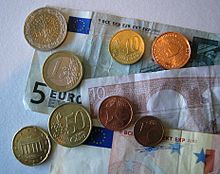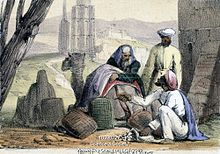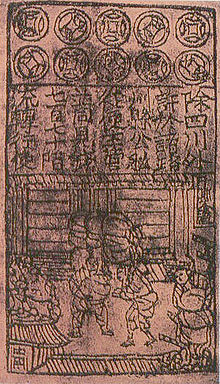
Currency
Did you know...
SOS believes education gives a better chance in life to children in the developing world too. Sponsor a child to make a real difference.
| Numismatics |
|---|
 |
| Currency |
| Community currencies |
|
| Fictional currencies |
| History |
| Ancient currencies |
|
| Byzantine |
| Medieval currencies |
| Modern currencies |
|
| Production |
|
| Exonumia |
|
| Notaphily |
| Scripophily |
|
|
A currency (from Middle English curraunt, meaning in circulation) in the most specific use of the word refers to money in any form when in actual use or circulation, as a medium of exchange, especially circulating paper money. This use is synonymous with banknotes, or (sometimes) with banknotes plus coins, meaning the physical tokens used for money by a government.
A much more general use of the word currency is anything that is used in any circumstances, as a medium of exchange. In this use, "currency" is a synonym for the concept of money.
A definition of intermediate generality is that a currency is a system of money (monetary units) in common use, especially in a nation. Under this definition, British pounds, U.S. dollars, and European euros are different types of currency, or currencies. Currencies in this definition need not be physical objects, but as stores of value are subject to trading between nations in foreign exchange markets, which determine the relative values of the different currencies. Currencies in the sense used by foreign exchange markets, are defined by governments, and each type has limited boundaries of acceptance.
The former definitions of the term "currency" are discussed in their respective synonymous articles banknote, coin, and money. The latter definition, pertaining to the currency systems of nations, is the topic of this article.
History
Early currency
Currency evolved from two basic innovations, both of which had occurred by 2000 BC. Originally money was a form of receipt, representing grain stored in temple granaries in Sumer in ancient Mesopotamia, then Ancient Egypt.
This first stage of currency, where metals were used to represent stored value, and symbols to represent commodities, formed the basis of trade in the Fertile Crescent for over 1500 years. However, the collapse of the Near Eastern trading system pointed to a flaw: in an era where there was no place that was safe to store value, the value of a circulating medium could only be as sound as the forces that defended that store. Trade could only reach as far as the credibility of that military. By the late Bronze Age, however, a series of treaties had established safe passage for merchants around the Eastern Mediterranean, spreading from Minoan Crete and Mycenae in the northwest to Elam and Bahrain in the southeast. Although it is not known what functioned as a currency to facilitate these exchanges, it is thought that ox-hide shaped ingots of copper, produced in Cyprus may have functioned as a currency. It is thought that the increase in piracy and raiding associated with the Bronze Age collapse, possibly produced by the Peoples of the Sea, brought this trading system to an end. It was only with the recovery of Phoenician trade in the ninth and tenth centuries BC that saw a return to prosperity, and the appearance of real coinage, possibly first in Anatolia with Croesus of Lydia and subsequently with the Greeks and Persians. In Africa many forms of value store have been used including beads, ingots, ivory, various forms of weapons, livestock, the manilla currency, ochre and other earth oxides, and so on. The manilla rings of West Africa were one of the currencies used from the 15th century onwards to buy and sell slaves. African currency is still notable for its variety, and in many places various forms of barter still apply.
Coinage
These factors led to the shift of the store of value being the metal itself: at first silver, then both silver and gold, at one point there was bronze as well. Now we have copper coins and other non-precious metals as coins. Metals were mined, weighed, and stamped into coins. This was to assure the individual taking the coin that he was getting a certain known weight of precious metal. Coins could be counterfeited, but they also created a new unit of account, which helped lead to banking. Archimedes' principle provided the next link: coins could now be easily tested for their fine weight of metal, and thus the value of a coin could be determined, even if it had been shaved, debased or otherwise tampered with (see Numismatics).
In most major economies using coinage, copper, silver and gold formed three tiers of coins. Gold coins were used for large purchases, payment of the military and backing of state activities. Silver coins were used for midsized transactions, and as a unit of account for taxes, dues, contracts and fealty, while copper coins represented the coinage of common transaction. This system had been used in ancient India since the time of the Mahajanapadas. In Europe, this system worked through the medieval period because there was virtually no new gold, silver or copper introduced through mining or conquest. Thus the overall ratios of the three coinages remained roughly equivalent. It is most significant.
Paper money
In premodern China, the need for credit and for circulating a medium that was less of a burden than exchanging thousands of copper coins led to the introduction of paper money, commonly known today as banknotes. This economic phenomenon was a slow and gradual process that took place from the late Tang Dynasty (618–907) into the Song Dynasty (960–1279). It began as a means for merchants to exchange heavy coinage for receipts of deposit issued as promissory notes from shops of wholesalers, notes that were valid for temporary use in a small regional territory. In the 10th century, the Song Dynasty government began circulating these notes amongst the traders in their monopolized salt industry. The Song government granted several shops the sole right to issue banknotes, and in the early 12th century the government finally took over these shops to produce state-issued currency. Yet the banknotes issued were still regionally valid and temporary; it was not until the mid 13th century that a standard and uniform government issue of paper money was made into an acceptable nationwide currency. The already widespread methods of woodblock printing and then Pi Sheng's movable type printing by the 11th century was the impetus for the massive production of paper money in premodern China.
At around the same time in the medieval Islamic world, a vigorous monetary economy was created during the 7th–12th centuries on the basis of the expanding levels of circulation of a stable high-value currency (the dinar). Innovations introduced by Muslim economists, traders and merchants include the earliest uses of credit, cheques, promissory notes, savings accounts, transactional accounts, loaning, trusts, exchange rates, the transfer of credit and debt, and banking institutions for loans and deposits.
In Europe, paper money was first introduced on a regular basis in Sweden in 1661 (although Washington Irving records an earlier emergency use of it, by the Spanish in a siege during the Conquest of Granada). Sweden was rich in copper, thus, because of copper's low value, extraordinarily big coins (often weighing several kilograms) had to be made.
The advantages of paper currency were numerous: it reduced transport of gold and silver, and thus lowered the risks; it made loaning gold or silver at interest easier, since the specie (gold or silver) never left the possession of the lender until someone else redeemed the note; and it allowed for a division of currency into credit and specie backed forms. It enabled the sale of stock in joint stock companies, and the redemption of those shares in paper.
However, these advantages held within them disadvantages. First, since a note has no intrinsic value, there was nothing to stop issuing authorities from printing more of it than they had specie to back it with. Second, because it increased the money supply, it increased inflationary pressures, a fact observed by David Hume in the 18th century. The result is that paper money would often lead to an inflationary bubble, which could collapse if people began demanding hard money, causing the demand for paper notes to fall to zero. The printing of paper money was also associated with wars, and financing of wars, and therefore regarded as part of maintaining a standing army. For these reasons, paper currency was held in suspicion and hostility in Europe and America. It was also addictive, since the speculative profits of trade and capital creation were quite large. Major nations established mints to print money and mint coins, and branches of their treasury to collect taxes and hold gold and silver stock.
At this time both silver and gold were considered legal tender, and accepted by governments for taxes. However, the instability in the ratio between the two grew over the course of the 19th century, with the increase both in supply of these metals, particularly silver, and of trade. This is called bimetallism and the attempt to create a bimetallic standard where both gold and silver backed currency remained in circulation occupied the efforts of inflationists. Governments at this point could use currency as an instrument of policy, printing paper currency such as the United States Greenback, to pay for military expenditures. They could also set the terms at which they would redeem notes for specie, by limiting the amount of purchase, or the minimum amount that could be redeemed.
By 1900, most of the industrializing nations were on some form of gold standard, with paper notes and silver coins constituting the circulating medium. Private banks and governments across the world followed Gresham's Law: keeping gold and silver paid, but paying out in notes. This did not happen all around the world at the same time, but occurred sporadically, generally in times of war or financial crisis, beginning in the early part of the 20th century and continuing across the world until the late 20th century, when the regime of floating fiat currencies came into force. One of the last countries to break away from the gold standard was the United States in 1971.
No country anywhere in the world today has an enforceable gold standard or silver standard currency system.
Banknote era
A banknote (more commonly known as a bill in the United States and Canada) is a type of currency, and commonly used as legal tender in many jurisdictions. With coins, banknotes make up the cash form of all money. Banknotes are mostly paper, but Australia's Commonwealth Scientific and Industrial Research Organisation developed the world's first polymer currency in the 1980s that went into circulation on the nation's bicentenary in 1988. Now used in some 22 countries (over 40 if counting commemorative issues), polymer currency dramatically improves the life span of banknotes and prevents counterfeiting.
Modern currencies
To find out which currency is used in a particular country, check list of circulating currencies.
Currency use is based on the concept of lex monetae; that a sovereign state decides which currency it shall use. Currently, the International Organization for Standardization has introduced a three-letter system of codes ( ISO 4217) to define currency (as opposed to simple names or currency signs), in order to remove the confusion that there are dozens of currencies called the dollar and many called the franc. Even the pound is used in nearly a dozen different countries, all, of course, with wildly differing values. In general, the three-letter code uses the ISO 3166-1 country code for the first two letters and the first letter of the name of the currency (D for dollar, for instance) as the third letter. United States currency, for instance is globally referred to as USD. It is also possible for a currency to be internet-based and digital, for instance, Bitcoin, the Ripple Pay system or MintChip, and not tied to any specific country.
The International Monetary Fund uses a variant system when referring to national currencies.
Control and production
In most cases, a central bank has monopoly control over emission of coins and banknotes ( fiat money) for its own area of circulation (a country or group of countries); it regulates the production of currency by banks ( credit) through monetary policy.
In order to facilitate trade between these currency zones, there are different exchange rates, which are the prices at which currencies (and the goods and services of individual currency zones) can be exchanged against each other. Currencies can be classified as either floating currencies or fixed currencies based on their exchange rate regime.
In cases where a country does have control of its own currency, that control is exercised either by a central bank or by a Ministry of Finance. In either case, the institution that has control of monetary policy is referred to as the monetary authority. Monetary authorities have varying degrees of autonomy from the governments that create them. In the United States, the Federal Reserve System operates without direct oversight by the legislative or executive branches. A monetary authority is created and supported by its sponsoring government, so independence can be reduced by the legislative or executive authority that creates it.
Several countries can use the same name for their own distinct currencies (for example, dollar in Australia, Canada and the United States). By contrast, several countries can also use the same currency (for example, the euro), or one country can declare the currency of another country to be legal tender. For example, Panama and El Salvador have declared U.S. currency to be legal tender, and from 1791–1857, Spanish silver coins were legal tender in the United States. At various times countries have either re-stamped foreign coins, or used currency board issuing one note of currency for each note of a foreign government held, as Ecuador currently does.
Each currency typically has a main currency unit (the dollar, for example, or the euro) and a fractional currency, often valued at 1⁄100 of the main currency: 100 cents = 1 dollar, 100 centimes = 1 franc, 100 pence = 1 pound, although units of 1⁄10 or 1⁄1000 are also common. Some currencies do not have any smaller units at all, such as the Icelandic króna.
Mauritania and Madagascar are the only remaining countries that do not use the decimal system; instead, the Mauritanian ouguiya is divided into 5 khoums, while the Malagasy ariary is divided into 5 iraimbilanja. In these countries, words like dollar or pound "were simply names for given weights of gold." Due to inflation khoums and iraimbilanja have in practice fallen into disuse. (See non-decimal currencies for other historic currencies with non-decimal divisions).
Currency convertibility
Convertibility of a currency determines the ability of an individual, corporate or government to convert its local currency to another currency or vice versa with or without central bank/government intervention. Based on the above restrictions or free and readily conversion features currencies are classified as:
- Fully Convertible - When there are no restrictions or limitations on the amount of currency that can be traded on the international market, and the government does not artificially impose a fixed value or minimum value on the currency in international trade. The US dollar is an example of a fully convertible currency and for this reason, US dollars are one of the major currencies traded in the FOREX market.
- Partially Convertible - Central Banks control international investments flowing in and out of the country, while most domestic trade transactions are handled without any special requirements, there are significant restrictions on international investing and special approval is often required in order to convert into other currencies. The Indian Rupee is an example of a partially convertible currency.
- Nonconvertible - Neither participate in the international FOREX market nor allow conversion of these currencies by individuals or companies. As a result, these currencies are known as blocked currencies. e.g.: North Korean Won and the Cuban Peso
Local currencies
In economics, a local currency is a currency not backed by a national government, and intended to trade only in a small area. Advocates such as Jane Jacobs argue that this enables an economically depressed region to pull itself up, by giving the people living there a medium of exchange that they can use to exchange services and locally produced goods (In a broader sense, this is the original purpose of all money.) Opponents of this concept argue that local currency creates a barrier which can interfere with economies of scale and comparative advantage, and that in some cases they can serve as a means of tax evasion.
Local currencies can also come into being when there is economic turmoil involving the national currency. An example of this is the Argentinian economic crisis of 2002 in which IOUs issued by local governments quickly took on some of the characteristics of local currencies.
One of the best examples of a local currency is the original LETS currency, founded on Vancouver Island in the early 1980s. In 1982 the Canadian Central Bank’s lending rates ran up to 14% which drove chartered bank lending rates as high as 19%. The resulting currency and credit scarcity left island residents with few options other than to create a local currency.




